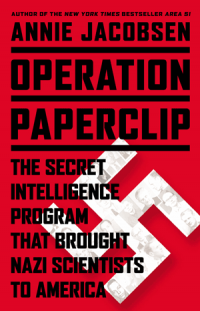“I don’t believe stories are one-sided, or easily made simple.” ~ Annie Jacobsen
By Catherine Austin Fitts
I listened to Annie Jacobsen’s reading of her book Operation Paperclip on the drive to California. Jacobsen is a investigative reporter who just published her study of Paperclip this year. Listening to detailed accounts of history is one of the many benefits of a 1,000 mile drive straight west on Interstate 40.
I am well acquainted with the Paperclip story through Linda Hunt’s The Paperclip Conspiracy, the excellent works of Dr. Joseph Farrell on the Nazis and their evolution after WWII as well as Christopher Simpson’s Blowback. I have also, on occasion, run into a Paperclip scientist or doctor or someone who had worked with one. Nevertheless, I found Jacobsen’s work fascinating, adding additional detail to my understanding.
Jacobsen clearly did a significant job digging into government documents and details. She follows the cases of a number of scientists and doctors through the war, the Nuremberg trials, the integration into the US military industrial complex and the marketing – positive and negative – of their contributions.
There is a great deal of detail that informed how Nazis were integrated back into the global military industrial machine by what I call “the megastructure.” Jacobsen also does a good job of describing the bureaucratic and media issues involved in managing the recruitment and integration of this many Germans into sensitive jobs in the United States immediately after the war.
At various times in my life I have studied the near infinite number of ways that the US intelligence agencies maintain in their toolkits to kill, disable and maim human beings – often in a quiet, invisible manner. As I drove across the country, I was astonished as I listened to the medical technology developed using slave labor by the Nazis who came to the United States through Operation Paperclip.
“Ah, so that is how you kill someone by filling their rubber boots with ice water. You learned that technique from the Nazi doctors that were sent to San Antonio.” These are insights at the subatomic particle level that offer rich, historical insight as to how we got to the current milieu.
Another valuable aspect that Jacobsen dives into is the managerial process by which the Nazi’s ran their underground operations using slave labor. As we hear about reports about extensive underground bases in the US as well as large numbers of unreported, unexplained illegal immigrants, it is a piece of history that is gruesome, but worth knowing.
People often ask me how the slow burn is engineered. Sometimes I feel like saying, “you don’t want to know.”
Related Solari Report:
Oligarchies & Their Fronts – Catherine and Dr. Joseph Farrell on the “metastructure’s” integration of the Nazi’s back into the global military infrastructure
Related Reading:
Annie Jacobsen’s Operation Paperclip
Operation Paperclip on Wikipedia





Hi Catherine ! The source I have for this info is “Fleshing Out Skull and Bones” . This author has a very interesting essay in the book about the top guy n the Nazi regime and his high level friends in the US Gov that wined and dined him and helped him set up the CIA. That book is by Kris Mulligan. whose own father was in CIA…and told his son all about it.